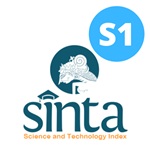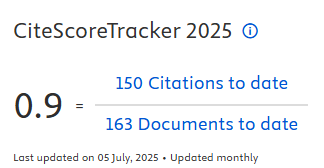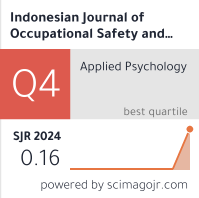Job and Organizational Factors Determining Nurses' Work Stress at Regional General Hospital

Downloads
Introduction: One of the government hospitals in South Sulawesi is facing various challenges related to nurses' working conditions, such as work stress. Preliminary data show that high work pressure, the nursing shift system, and the ratio of nurses to patients contribute to this condition and are predicted as risk factors that can affect the quality of work life for nurses. Methods: This study aim is to examine how organizational and job-related factors affect hospital nurses' work stress at regional hospital. Using a cross-sectional methodology, this study included 167 nurses out of 287 who were chosen by accident sampling. Questionnaires, observations, and interviews were used to gather data, which were then subjected to linear regression analysis (95% CI; α=0.05). Results: The results of this study indicate that work stress is significantly influenced by the job factor (p=0.000; β=0.415) and organizational factor (p=0.011; β= -0.229). Emotional demands are the most influential component of job factors on the emergence of stress. Conclusion: High job demands, especially emotional burden, significantly increase nurses' work stress, whereas good organizational support can reduce it. These findings indicate the importance of reducing emotional burden and increasing institutional support through mental resilience training, structured debriefing sessions, peer support systems, and psychological counseling services. The results of this study can also be used as a basis for policy making by hospital leaders to be more supportive of nurses' mental well-being and the sustainability of health service quality.
Albelbeisi, A.H. et al. (2024) ‘Occupational Stress and Associated Sources and Risk Factors among Nurses in Gaza Strip, Palestine: A Cross-sectional Survey’, Nursing Open, 11(8), pp. 1–8. Available at: https://doi.org/10.1002/nop2.70004.
Alrashidi, N.A. et al. (2022) ‘Prevalence of Work-Related Stress and its Associated Factors among Healthcare Professionals at Jazan Region, Saudi Arabia’, Journal of Pharmaceutical Negative Results, 13(S01), pp. 1174–1183. Available at: https://doi.org/10.47750/pnr.2022.13.s01.144.
Alruwaili, M.M. et al. (2022) ‘Experiences, Perceptions, and Coping Patterns of Emergency Department Nurses with Occupational Stressors in Saudi Arabian Hospitals: Mixed-Method Study’, Healthcare, 10(8), p. 1504. Available at: https://doi.org/10.3390/healthcare10081504.
Anwar, B. et al. (2025) ‘Work Stress in Nurses and Its Influence on Patient Care and Quality of Life’, Biological and Clinical Sciences Research Journal, 6(1), pp. 142–145. Available at: https://doi.org/https://doi.org/10.54112/bcsrj.v6i1.1538.
ASEAN Secretariat (2023) ASEAN Employment Outlook: The Quest for Decent Work in Platform Economy: Issues, Opportunities and Ways Forward. Jakarta.
Azemi, S. et al. (2022) ‘Work-related Stress, Self-Efficacy and Mental Health of Hospital Nurses’, Work, 72(3), pp. 1007–1014. Available at: https://doi.org/10.3233/WOR-210264.
Babapour, A.R., Gahassab-Mozaffari, N. and Fathnezhad-Kazemi, A. (2022) ‘Nurses’ Job Stress and its Impact on Quality of Life and Caring Behaviors: A Cross-sectional Study’, BMC Nursing, 21(75), pp. 1–10. Available at: https://doi.org/10.1186/s12912-022-00852-y.
Bakker, A.B. and Demerouti, E. (2007) ‘The Job Demands‐Resources Model: State of the Art’, Journal of Managerial Psychology, 22(3), pp. 309–328. Available at: https://doi.org/https://doi.org/10.1108/02683940710733115.
Baye, Y. et al. (2020) ‘Nurses’ Work-related Stress and Associated Factors in Governmental Hospitals in Harar, Eastern Ethiopia: A Cross-sectional Study’, PLoS ONE, 15(8 August), pp. 1–12. Available at: https://doi.org/10.1371/journal.pone.0236782.
Berutu, M.B. and Ilhami, S.D. (2024) ‘Organizational Climate and Job Satisfaction of Nurses: The Mediating Roles of Job Stress’, Organizational Psychology, 14(4), pp. 136–150. Available at: https://doi.org/10.17323/2312-5942-2024-14-4-136-150.
Clinchamps, M. et al. (2024) ‘Exploring the Relationship between Occupational Stress, Physical Activity and Sedentary Behavior using the Job-Demand-Control Model’, Frontiers in Public Health, 12(October), pp. 1–13. Available at: https://doi.org/10.3389/fpubh.2024.1392365.
Edwards, J.R. and Cooper, C.L. (1990) ‘The Person-environment Fit Approach to Stress: Recurring Problems and Some Suggested Solutions’, Journal of Organizational Behavior, 11(4), pp. 293–307. Available at: https://doi.org/10.4324/9781315196244-37.
Eisenberger, R. et al. (1986) ‘Perceived Organizational Support’, Journal of Applied Psychology, 71, pp. 500–507. Available at: https://doi.org/10.1037/0021-9010.71.3.500.
Elmagd, M.H.A., Khamis, H.M. and Ali, H.Y.S. (2024) ‘Determinant of Work Related Stress among Nursing Staff: A Systematic Review’, Tanta Scientific Nursing Journal, 33(2), pp. 310–326.
Ghaderi, Z. et al. (2024) ‘Predictive Factors of Occupational Stress among Nurses during the COVID-19 Pandemic: A Cross-sectional Study in Kashan, Iran’, BMC Nursing, 23(1), pp. 1–8. Available at: https://doi.org/10.1186/s12912-024-01967-0.
Gmayinaam, V.U. et al. (2024) ‘Work-related Stress among Nurses: A Comparative Cross-sectional Study of Two Government Hospitals in Ghana’, BMC Public Health, 24(2257). Available at: https://doi.org/10.1186/s12889-024-19757-3.
Health and Safety Executive (HSE) (2023) Work-related stress, depression or anxiety statistics in Great Britain, 2023. Available at: https://www.hse.gov.uk/statistics/assets/docs/stress.pdf.
Hu, X. et al. (2024) ‘Risk Factors for Anxiety, Depression, Stress, and their Comorbidities among Nurses: A Prospective Cohort From 2020 to 2022’, BMC Nursing, 23(916), pp. 1–11. Available at: https://doi.org/10.1186/s12912-024-02577-6.
International Labour Organization (2022) Working Time and Work-life Balance around the World. Geneva: International Labour Organization Publications.
Jessica, N. et al. (2023) ‘The Effect of Work Environment and Work-life Balance on Job Satisfaction: Work Stress as a Mediator’, Journal of Economics, Management and Trade, 29(1), pp. 54–65. Available at: https://doi.org/10.9734/jemt/2023/v29i11074.
Karasek, R.A. (1979) ‘Job Demands, Job Decision Latitude, and Mental Strain: Implications for Job Redesign’, Administrative Science Quarterly, 24(2), pp. 285–308. Available at: https://doi.org/10.2307/2392498.
Lazarus, R.S. and Folkman, S. (1984) Stress, Appraisal, and Coping. New York: McGraw-Hill, Inc.
Liao, H. et al. (2022) ‘Work Stress, Burnout, Occupational Commitment, and Social Support among Chinese Pediatric Nurses: A Moderated Mediation Model’, Journal of Pediatric Nursing, 67, pp. e16–e23. Available at: https://doi.org/10.1016/j.pedn.2022.10.009.
Liu, Y. et al. (2021) ‘Job Stress, Psychological Capital, Perceived Social Support, and Occupational Burnout Among Hospital Nurses’, Journal of Nursing Scholarship, 53(4), pp. 511–518. Available at: https://doi.org/10.1111/jnu.12642.
Al Muala, I. et al. (2022) ‘Evaluating the Effect of Organizational Justice on Turnover Intention in the Public Hospitals of Jordan: Mediated-Moderated Model of Employee Silence, Workplace Bullying, and Work Stress’, International Journal of Professional Business Review, 7(3), pp. 1–23. Available at: https://doi.org/10.26668/businessreview/2022.v7i3.0526.
Parashakti, R.D. and Ekhsan, M. (2022) ‘Peran Burnout Sebagai Mediasi Pada Pengaruh Stres Kerja Terhadap Kinerja Karyawan’, Jurnal Ekonomi & Ekonomi Syariah, 5(1), pp. 365–373.
Sugiyono (2014) Metode Penelitian Kombinasi (Mixed Methods). 6th edn. Bandung: Alfabeta.
Swarjana, I.K. (2015) Metodologi Penelitian Kesehatan (Edisi Revisi). 2nd edn. Yogyakarta: Penerbit ANDI.
The Marlin Company and The American Institute of Stress (2001) The Workplace Stress ScaleTM. Available at: https://www.stress.org/wp-content/uploads/2023/02/The-Workplace-Stress-Scale.pdf.
Tsegaw, S., Getachew, Y. and Tegegne, B. (2022) ‘Determinants of Work-Related Stress Among Nurses Working in Private and Public Hospitals in Dessie City, 2021: Comparative Cross-Sectional Study’, Psychology Research and Behavior Management, 15(July), pp. 1823–1835. Available at: https://doi.org/10.2147/PRBM.S372882.
World Health Organization (WHO) (2023) Depressive disorder (depression). Available at: https://www.who.int/news-room/fact-sheets/detail/depression.
Zhang, X., Huang, L. and Li, Y. (2022) ‘Organizational Support and Well-being among Nurses: Evidence from a Large-scale Study in China’, BMC Nursing, 21(1), pp. 1–12.
Zukhri, S., Suciana, F. and Kusumo, H.P. (2021) ‘Hubungan Stres Kerja dan Kepuasan Kerja Dengan Kualitas Hidup Perawat ICU-ICCU RSU Islam Klaten’, Prosiding Seminar Nasional UNIMUS, 4, pp. 1731–1739.

This work is licensed under a Creative Commons Attribution-NonCommercial-ShareAlike 4.0 International License.

In order to be accepted and published by The Indonesian Journal of Occupational Safety and Health, Author(s) who submit an article should complete all the review process. The copyright of received articles assigned to the The Indonesian Journal of Occupational Safety and Health and Department of Safety and Health, Universitas Airlangga as publishers of the journal. The intended copyright includes the rights to publish articles in various forms (including reprints).
The Editorial Team of The Indonesian Journal Of Occupational Safety and Health and Department of Safety and Health strive to ensure that no errors occur in the articles that have been published, both data errors and statements in the article.
Users of this website will be licensed to use materials from this website following the Creative Commons Attribution-NonCommercial-ShareAlike 4.0 International License. No fees charged. Please use the materials accordingly.
------------------------------------------------------------------------------------------------------------------------------------------------------------------------------------------
Attribution ” You must give appropriate credit, provide a link to the license, and indicate if changes were made. You may do so in any reasonable manner, but not in any way that suggests the licensor endorses you or your use.
NonCommercial ” You may not use the material for commercial purposes.
ShareAlike ” If you remix, transform, or build upon the material, you must distribute your contributions under the same license as the original.







 How to Submit Articles in OJS
How to Submit Articles in OJS

























